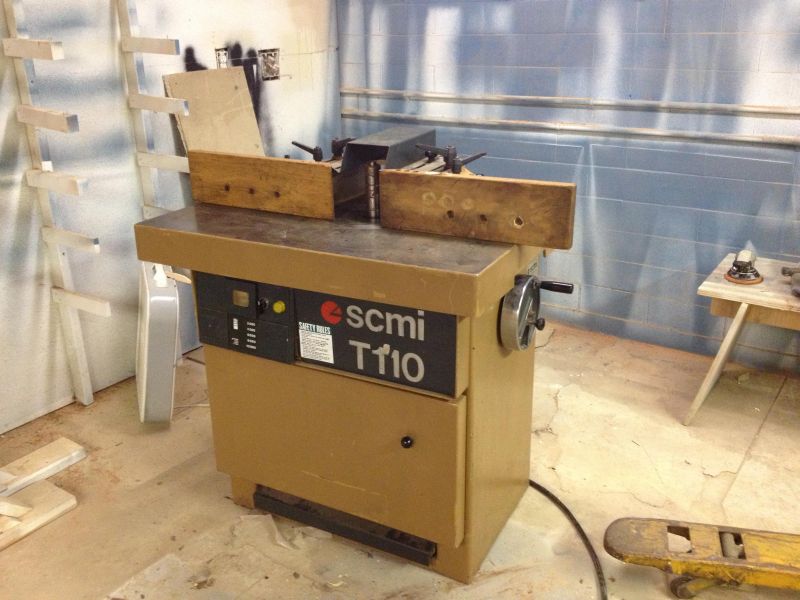Modifying a Shaper to Run in Reverse
A question about setting up a second-hand shaper leads to an informative discussion about the fine points of running machinery in both forward and reverse directions. September 18, 2014
Question (WOODWEB Member) :
I have recently acquired an SCMI t110 which has no reversing switch. I'm looking to use the shaper in both forward and reverse so I don't want to wire it only in reverse or vice versa. Is this something that is doable by buying a new switch through SCMI and simply wiring it? I called the tech support but they were not extremely helpful. Since this machine is from 1985 itís difficult to find any literature on the wiring of it. Any help would be appreciated.

Click here for higher quality, full size image
Forum Responses
(Solid Wood Machining Forum)
From contributor S:
I would research this further online, but I am certain any three phase motor can be reversed simply by reversing any of the legs, thus a reversing switch should do what you want. Just make sure it is rated for the application.
From contributor F:
This is probably pretty obvious, but make sure the machine was originally a reversing machine before slapping a switch on it. Not all machines were made to reverse, reversing one not made to could be a very bad idea.
From Contributor S:
What is that switch next to the stop button? It looks like a lever style that could point left or right? I think what Contributor F would be referring to is the spindle setup. Make sure you won't have a lock nut loosening if you run reverse. Contributor S is correct about swapping out any two of the three legs to reverse a 3-phase motor but it's is a bit more complicated if it is single phase. Either can be reversed with one of a couple special switches though. Personally I've never seen a shaper not set up for forward and reverse.
From contributor F:
I honestly don't know if it matters on the newer shapers. Older shapers sometimes made use of spindles that threaded onto the quill, or spindles held in place by through bolts. Running in reverse could have bad consequences! I hadn't thought about reversing spindle direction on a double spindle shaper. It was then explained to me by some folks much more knowledgeable how foolish an idea it really was.
From Contributor U:
"What is that switch next to the stop button? It looks like a lever style that could point left or right?" I was wondering the same thing. Some SCM shapers have a momentary contact switch like this where normal rotation is the default unless you turn the switch (then the yellow light comes on) and start the machine.
From Contributor D:
We have a T120 and added a reversing switch. The only potential for trouble is that the nut is not going to be in "auto-tighten" mode when running in reverse, but as long as you properly tighten the nut that should not be an issue. As pointed out by an earlier poster, all 3-phase motors can run in either direction, it's just a matter of reversing any two of the three hot wires. We just had our electrician add a box with a switch and it works great. Just make sure that the switch you get can handle the running amperage. It doesn't need to have a starter rating, as it will already be thrown when the current is applied (you can't reverse it while in operation). Please note: I am not an electrician, and modifying any equipment in any way is potentially dangerous to life, limb and property.
From Contributor H:
Further note for if it is 3-phase and you have a 3-phase converter. Do your wire swapping with the pair of wires from the street, not with the generated leg. Some electronics do not work right with a less than perfect generated leg. When I had my T-110 hooked up to a rotary converter I had to carefully select which of the three line connection terminals got the generated leg for the machine to run properly. If only the motor was involved this would not be an issue. However swapping lines that also go to the electronics can cause problems.
From Contributor O:
Someone needs to state that when running in counterclockwise rotation, the spindle needs to have an anti-rotating washer between the spindle nut and spacers or tooling. This type of washer has a tooth that fits into a slot milled along the length of the spindle. On my big SCMI, the tooth is about 3/16" wide and 3/16" projection, and the washer is about 1/8" thick, milled. This simple safety prevents the nut from being turned (to loosen) in the event of the tooling spinning on the spindle while running. I learned that this is preferable to double nutting the spindle and far more preferable to wrenching the nut 'real tight!'
From the original questioner:
Thank you all for your responses. I spoke to SCMI on the phone and they assured me that it could be reversed. I think whoever had the machine before me had skipped the switch to the left which may be the reverse switch. The wiring has definitely been adjusted before. I understand that three phase can be reversed and I looked at drum switches on Grainger in order to run in reverse without buying a switch from SCMI. This will be running off of a phase converter so I do appreciate the info on that. Thank you all for your help and cautionary knowledge.
